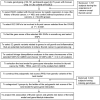Association of Polygenetic Risk Scores Related to Cell Differentiation and Inflammation with Thyroid Cancer Risk and Genetic Interaction with Dietary Intake
- PMID: 33805984
- PMCID: PMC8038131
- DOI: 10.3390/cancers13071510
Association of Polygenetic Risk Scores Related to Cell Differentiation and Inflammation with Thyroid Cancer Risk and Genetic Interaction with Dietary Intake
Abstract
The incidence of thyroid cancer continues to increase steadily, and this increasing incidence cannot be attributed solely to the overdiagnosis of microcarcinoma or technical advancements in detection methods and may also depend on environmental and genetic factors. However, the impacts and interactions of genetic and environmental factors remain controversial, and they may differ in Eastern and Western countries. The study's purpose was to identify single nucleotide polymorphisms of genes related to cell differentiation and inflammation to influence thyroid cancer incidence and determine interactions with lifestyles in a large city hospital-based cohort. Genetic variants were selected by genome-wide association study with thyroid cancer participants (case; n = 495) and controls without cancers (n = 56,439). SNPs having gene-gene interactions were selected by generalized multifactor dimensionality reduction. Polygenic risk scores (PRSs) were generated by summing the number of selected SNP risk alleles. PRSs of the best model included 6 SNPs, that is, DIRC3_rs6759952, GAP43_rs13059137, NRG1_rs7834206, PROM1_rs72616195, LRP1B_rs1369535, and LOC100507065_rs11175834. Participants with a high-PRS had a higher thyroid cancer risk by 3.9-fold than those with a low-PRS. The following variables were related to an increased thyroid cancer risk; female (OR = 4.21), high white blood cell count (OR = 4.03), and high energy (OR = 7.00), low alcohol (OR = 4.11), and high seaweed (OR = 4.02) intakes. These variables also interacted with PRS to influence thyroid cancer risk. Meat/noodle diet patterns interacted with PRSs to increase thyroid cancer risk (p = 0.0023). In conclusion, women with a high-PRS associated with cell differentiation and inflammation were at an elevated thyroid cancer risk. Daily energy, seaweeds, and alcohol intake interacted with PRS for thyroid cancer risk. These results could be applied to personalized nutrition plans to reduce the risk of thyroid cancer.
Keywords: dietary patterns; gender; gene–gene interaction; polygenic risk scores; thyroid cancer; white blood cell.
Conflict of interest statement
The authors declare no conflict of interest.
Figures



Similar articles
-
Association of Polygenetic Risk Scores Related to Immunity and Inflammation with Hyperthyroidism Risk and Interactions between the Polygenetic Scores and Dietary Factors in a Large Cohort.J Thyroid Res. 2021 Sep 14;2021:7664641. doi: 10.1155/2021/7664641. eCollection 2021. J Thyroid Res. 2021. PMID: 34567510 Free PMC article.
-
Association between Polygenetic Risk Scores of Low Immunity and Interactions between These Scores and Moderate Fat Intake in a Large Cohort.Nutrients. 2021 Aug 19;13(8):2849. doi: 10.3390/nu13082849. Nutrients. 2021. PMID: 34445011 Free PMC article.
-
Association of Estrogen-Related Polygenetic Risk Scores with Breast Cancer and Interactions with Alcohol Intake, Early Menarche, and Nulligravida.Asian Pac J Cancer Prev. 2022 Jan 1;23(1):13-24. doi: 10.31557/APJCP.2022.23.1.13. Asian Pac J Cancer Prev. 2022. PMID: 35092367 Free PMC article.
-
Polygenetic Variants Related to Osteoarthritis Risk and Their Interactions with Energy, Protein, Fat, and Alcohol Intake in Adults in a Large Cohort.Diagnostics (Basel). 2022 Jan 28;12(2):340. doi: 10.3390/diagnostics12020340. Diagnostics (Basel). 2022. PMID: 35204431 Free PMC article.
-
Polygenic risk scores to stratify cancer screening should predict mortality not incidence.NPJ Precis Oncol. 2022 May 30;6(1):32. doi: 10.1038/s41698-022-00280-w. NPJ Precis Oncol. 2022. PMID: 35637246 Free PMC article. Review.
Cited by
-
Dietary intake and cancer incidence in Korean adults: a systematic review and meta-analysis of observational studies.Epidemiol Health. 2023;45:e2023102. doi: 10.4178/epih.e2023102. Epub 2023 Nov 30. Epidemiol Health. 2023. PMID: 38037322 Free PMC article.
-
Interactions between Polygenic Risk Scores, Dietary Pattern, and Menarche Age with the Obesity Risk in a Large Hospital-Based Cohort.Nutrients. 2021 Oct 25;13(11):3772. doi: 10.3390/nu13113772. Nutrients. 2021. PMID: 34836030 Free PMC article.
-
Association of Polygenetic Risk Scores Related to Immunity and Inflammation with Hyperthyroidism Risk and Interactions between the Polygenetic Scores and Dietary Factors in a Large Cohort.J Thyroid Res. 2021 Sep 14;2021:7664641. doi: 10.1155/2021/7664641. eCollection 2021. J Thyroid Res. 2021. PMID: 34567510 Free PMC article.
-
The regulation of LRPs by miRNAs in cancer: influencing cancer characteristics and responses to treatment.Cancer Cell Int. 2025 May 17;25(1):182. doi: 10.1186/s12935-025-03804-z. Cancer Cell Int. 2025. PMID: 40382654 Free PMC article. Review.
-
Morbid Obesity and Thyroid Cancer Rate. A Review of Literature.J Clin Med. 2021 Apr 27;10(9):1894. doi: 10.3390/jcm10091894. J Clin Med. 2021. PMID: 33925549 Free PMC article. Review.
References
-
- Liyanarachchi S., Gudmundsson J., Ferkingstad E., He H., Jonasson J.G., Tragante V., Asselbergs F.W., Xu L., Kiemeney L.A., Netea-Maier R.T., et al. Assessing thyroid cancer risk using polygenic risk scores. Proc. Natl. Acad. Sci. USA. 2020;117:5997–6002. doi: 10.1073/pnas.1919976117. - DOI - PMC - PubMed
Grants and funding
LinkOut - more resources
Full Text Sources
Other Literature Sources
Research Materials

